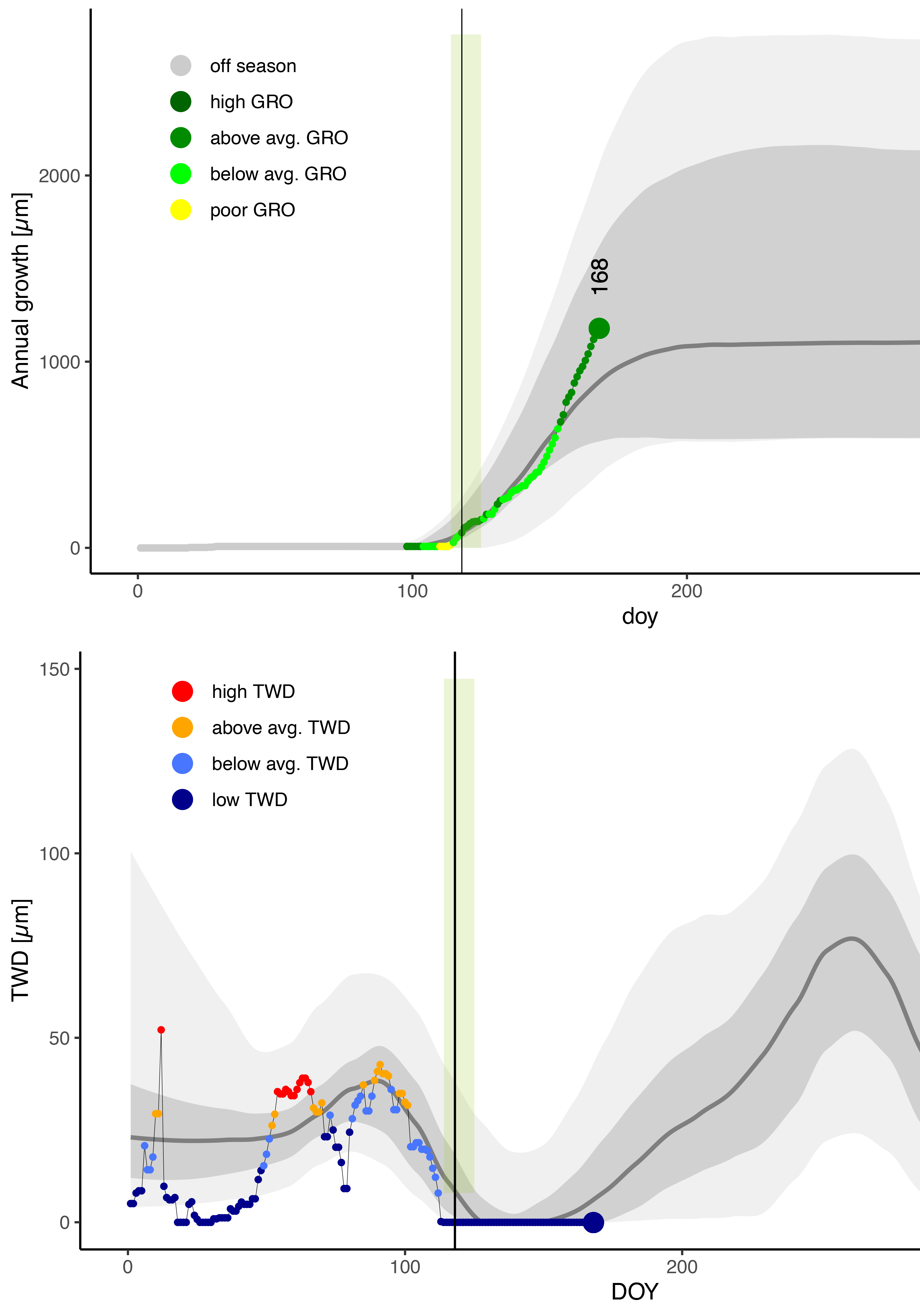
Data analyses
Natkon offers support with the analyses of dendrometer data
Data cleaning, gap filling, partitioning of dendrometer data into growth and tree water deficit fractions, calculation of growth-, NEP-, and drought stress indices.
From dendrometer readings to biological drought and growth indicators
Point dendrometers
Natkon point dendrometers are high precision devices that allow stem radius changes to be detected at a resolution of micrometers. The measurement devices consist of a mounting frame incl. an anchoring system and an electronic sensor with a sensor head slightly pressed against the surface of the measurement object by a spring. All parts of such measurement devices are more or less temperature sensitive. The quality of a dendrometer depends on the interaction of artificial responses of different parts of a device to temperature. High quality sensors, like the Natkon dendrometers, have an overall temperature sensitivity <0.5 µm per °C.

Figure M1 Dual point dendrometer ZN11-T-2IP (products). The carbon frames are either T-shaped (for large stems) or O-shaped (for small stems or branches) and are anchored in the stem with stainless steel rods. Up to three sensors are attached to the different type of frames in order to measure different expositions at the stem or to measure stem radius fluctuations over bark and on the xylem separately.
Stem radius changes – raw data
Tree stems usually shrink during the day and expand during the night. These fluctuations are mostly driven by tree water relations and their dependencies on conditions in air and soil. Trees are coupled to the air by many square meters of leaf area and to the soil by many square meters of root surface. Any change in conditions in air and soil affect tree water relations. The determining forces in tree water relations over a day start with the transpiration in the leaves (driven by a combination of vapor pressure deficit of the air, light and wind), being followed by the flow resistance- and storage capacitance-induced delay of sap flow in twigs, branches and stem, to finally a delayed depletion of elastic stem storage tissues at the location where the point dendrometer is mounted.
Figure M2 Stem radius change data as displayed in TreeNet in real-time (powered by DecentLab). The four panels show the measurements of four individual trees over 5 days. Typically, the radius of a tree begins decreasing with dawn, reaches its minimum in late afternoon, and increases during the night. Decreasing stems indicate a net water efflux out of the tree, increasing stems indicate a net water influx into the tree.
Growth processes in the cambium (the tissue between the wood and the bark of a stem) build new cells (mainly xylem and phloem). And these newly built tissues become visible in dendrometer readings over weeks and months as irreversible expansion of the stem size (Fig. M3). Periods of growth may be interrupted by periods of no-growth when weather conditions are unfavorable, e.g. due to drought.
Figure M3 Stem radius change data of two beech trees at the site Chamoson over a month. Growth leads to an irreversible stem expansion since the new wood cells get lignified and they do not disappear once they are built. Still visible are the water relations-induced diurnal variations of the stem radius.
Partitioning stem radius fluctuations into tree water deficit and growth
Natkon follows the partitioning concept (ZG-concept) presented by Zweifel in Plant, Cell and Environment (2015) and by Zweifel et al in New Phytologist (2016) but also considers the approach of Mencuccini et al. in Plant, Cell and Environment (2017). The ZG-concept allows to overcome a decade-old problem of turning raw stem radius displacement (SR) readings into physiologically reasonable measures. These physiologically reasonable measures are suggested to be growth-induced irreversible expansion of the stem (GRO) and the tree water deficit-induced shrinkage of the stem (TWD). GRO covers any increase in SR exceeding a precedent SR maximum. TWD covers any shrinkage of the stem plus the increase of SR during periods with shrunken stems.
Figure M4 (adapted from Zweifel, 2015, PCE) Transformation of stem radius change (SR) data into tree water deficit (TWD) and growth (GRO). The partitioning concept is based on the following assumptions:
o Decreasing SR are induced by reversible tissue shrinkage due to low water potentials (increasing TWD).
o Increasing SR above the current maximum indicate irreversible GRO.
o Increasing SR below a precedent SR maximum indicate reversible tissue expansion due to increasing water potentials (decreasing TWD).
The ZG-concept implicitly assumes that tree stems are not able to maintain growth processes (cell division and cell elongation) in the cambium during periods of shrunken stems.
Download an Excel based tool to apply the ZG-concept for your data
Download the latest version of treenetproc an R package for applying the ZG-concept to your data. Read the related paper of Knüsel et al_FORESTS_2021 explaining the features and the handling of treenetproc.



